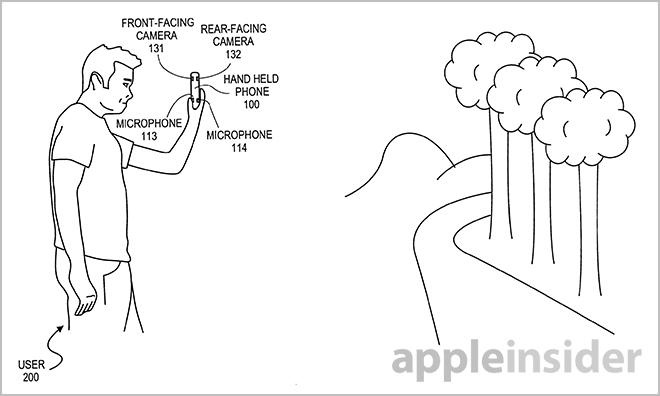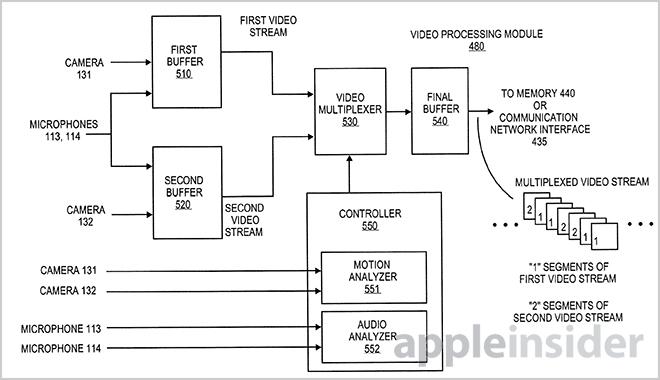A newly published patent application from Apple outlines teleconferencing and video capture technology that would process video from an iPhone's front and rear cameras simultaneously, and automatically determine which feed to stream based on voice or visual cues.
Apple's "Automatic video stream selection" patent application, published by the U.S. Patent and Trademark Office on Thursday, describes a system that can intelligently determine whether to use the video feed from a smartphone's front or rear facing camera. The tech can be used in a video calls, such as those made via Apple's FaceTime, or for content stored locally on a device.
As noted in the document, many handhelds have two cameras for video and picture taking. The shooters are typically facing in opposite directions, with the rear-facing module used for higher-resolution shots, while the front-facing unit handles video call duties.
With advancements in mobile processing power, some smartphones are able to capture video streams from both cameras simultaneously, though the use cases for such a feature have been limited. The iPhone currently uses only one camera at a time, offering users the option to toggle between the two as desired.
Apple notes that current bandwidth restrictions would make it difficult to stream both video feeds at the same time, thus a method is needed to intuitively select one while keeping audio in sync.
What Apple proposes is a system that captures and monitors two video streams for voice or visual cues, then outputs one of the two depending on a set of predetermined criteria. One example would be a FaceTime call in which a rear-facing camera video stream is being used before the feed automatically switches to the front-facing camera when a person begins to talk.
In order to decide which camera to use, the technology detects speech by using data from microphones facing in the same direction as each camera, or facial expressions such as lip movements.
One embodiment describes an "Auto-Select" indicator that, when selected, will activate the system and begin outputting the multiplexed video.
Various implementations are described in the paper, including "report mode," which captures a a scene from the rear-facing camera and switches to the user when they start talking. When no speech or lip movement is detected, the video switches back to the scene. Both video streams can be interleaved throughout the process and output to local storage.
In "interview mode," the phone is located between a user, who is being captured by the front-facing camera, and another person facing the rear camera. The video switches between the two when one person is determined to be speaking.
Interview mode.Finally, along with streaming the multiplexed video in a FaceTime call, the invention allows devices without cellular access to store the content, to be uploaded whenever a Wi-Fi connection is available.
While the invention relies heavily on software, there are hardware limitations, such as audio and video processors, that may restrict Apple from releasing such a feature in the near future. However, as the final specifications of the upcoming "iPhone 5S" have yet to be revealed, it is possible that the smartphone could have the necessary components baked in. As of now, iOS 7 beta does not carry such functionality.
Apple's automatic stream selection patent application was first filed for in May and credits Jae Han Lee and E-Cheng Chang as its inventors.
 Mikey Campbell
Mikey Campbell








-m.jpg)






 Thomas Sibilly
Thomas Sibilly
 Wesley Hilliard
Wesley Hilliard
 Marko Zivkovic
Marko Zivkovic

 Malcolm Owen
Malcolm Owen

 Amber Neely
Amber Neely










19 Comments
I like the Second Person (310) :) in the third illustration. :)
[quote name="Chandra69" url="/t/159260/apple-working-on-iphone-video-feature-that-automatically-switches-cameras-during-a-facetime-calls#post_2387082"]I like the [B]Second Person (310)[/B] :) in the third illustration. :) [/quote] You a David Cassidy fan?
Interesting patent !
To summarize what this could do, iOS could listen to your audio stream and use voice or lip movements to figure out what the speaker is talking about and automatically switch between front and back cameras.
For example : Say the front camera's active at the moment. When the user says, "Hey Jim take a look at my new computer i got", iOS could auto switch to the rear camera without ever having to manually do it. Pretty Powerful. Can you guys think of other implementations ?
[quote name="nikilok" url="/t/159260/apple-working-on-iphone-video-feature-that-automatically-switches-cameras-during-a-facetime-calls#post_2387089"]Can you guys think of other implementations ? [/quote] 1. Listen to me, I'm only gonna say this once... 2. I once killed a man with thiiiiiis thumb 3. Read my lips, no more tax increase
Shouldn't Apple be fixing things instead of mucking around with these fancy ideas that most likely won't see the light of day? The virtual keyboard is a joke. ICloud back ups that don't work. Home buttons that freeze up. I would prefer perfection or close to in their existing products that are used extensively.